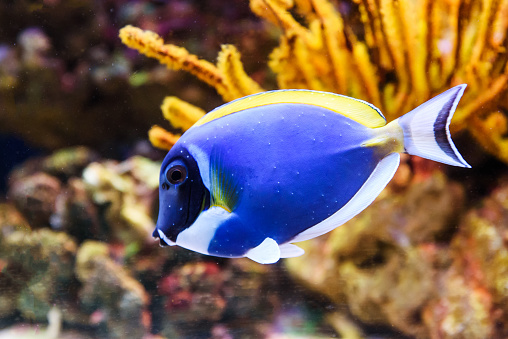ANIMAL: Powder Blue Tang/Surgeonfish Acanthurus leucosternon Type of Animal: Tang/Surgeonfish Habitat: Shallow waters-clear tropical coastal flat-top reefs, clear coastal reef areas along seaward slopes, reef flats, seaward reef slopes, coral reefs, found as deep as 82.021 ft Location(s): Indian Ocean & W Pacific ranging from E Africa to Andaman Sea/Christmas Island/Bali Appearance: Compressed lateral body w/ oval shape, powder blue on sides, yellow tail fin base/dorsal fin, black head area, small pointed beak-like mouth, transparent pectoral fins w/ yellow reflections, white mouth/throat area/anal fins/pelvic fins Food/Diet: Algae, seaweed, brine shrimp, worms, mysid shrimp, vegetable matter, fruit matter Status in Wild: Stable Conservation: Breeding in aquaculture, aquariums, & zoos. Captive breeding reducing demand for wild-caught fish. Lifestyle: Schools of 2-200 fish, territories often defended by school Additional Info: Called: Male Female Young: Acronurus Group: School Weight: Male: 6-10 oz Female: 9-14 oz Gestation: 1-2 days Life Span: 10-20 years in captivity, 30-40 years in wild Body Length: Male: 7 in Female: 9 in Young: 1 in Spawn in open water. They’re very active & fast swimmers. Besides using tail scalpels in defense, they’ll also use them in territorial fights. When eggs hatch, larvae look like small-mouthed/long-snouted little kites & stay in this stage for 1.5-2 months. Become juveniles at 2 months old & reach maturity at 9-12 months old. Active during the day (diurnal). Important in keeping reefs healthy due to algae-eating diet. Without these fish, algal overgrowths can occur. Eggs are pelagic & hatch a day or 2 after being released. Sometimes school w/ other fish species. Pointed snout allows them to get to algae in hard to reach places. Single female can lay tens of thousands of eggs. Spawn in pairs/groups, w/ males & females releasing sperm/eggs simultaneously. Fun Fact(s): Can change color based on mood. These fish very prone to marine ich/white-spot disease caused by ciliated protozoan parasite Cryptocaryon irritans, usually causing small white spots on gills/body/fins. This disease can often be even more serious, causing severe irritation/appetite loss/lethargy/severe respiratory distress/even death. Get surgeonfish name due to sharp spines along each side of tail base used in defense. These scalpel-like spines can cause nasty wounds. Also called doctorfish due to this. Fairly popular aquarium fish but like many tangs/surgeonfish, very difficult to captive breed. These fish are not for beginner hobbyists.
